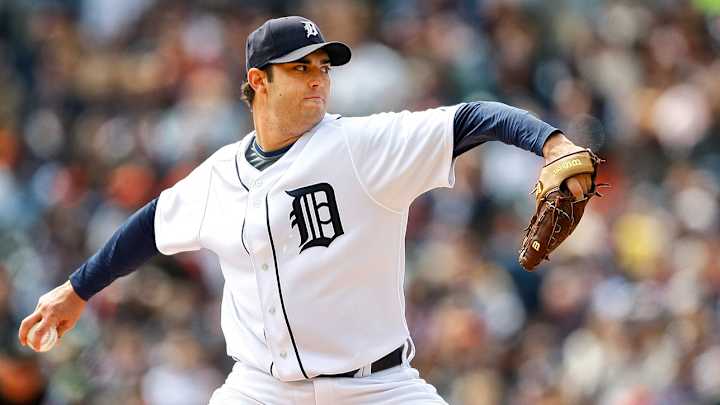Ten Years Later, Can We Say Armando Galarraga Was Perfect?

Most athletic achievements speak for themselves. Their names are self-evident—no one has to question the foundation of a “no-hitter” or “quadruple double” or “500-yard passing game.” There’s no space left for subjectivity.
And then there’s “perfect game.”
This breaks out from the aforementioned structures. (Just try figuring it out in the context of the other terms: "What does it mean to be perfect?” demands far more than “What does it mean to allow no hits?”) “Perfect” is heavy. Its standards can be technical, aesthetic, moral, philosophical, all of the above. It can be physically impossible. A perfect game does not sound like a statistical standard as much as it sounds like an ideal. Which is why it’s perhaps best understood in a game that’s known for its imperfection: Armando Galarraga’s, 10 years ago today.
By now, the details are well-worn, the framework of a narrative about grace and sportsmanship. Galarraga pitched 8 2/3 perfect innings, standing on the verge of the history. Then umpire Jim Joyce called a runner safe at first on what would have been the final out—a call he recognized as wrong almost immediately, which he admitted afterwards near tears. Galarraga forgave him. “Nobody’s perfect,” he said. A year later, the pitcher and ump co-wrote a book and made that the title: Nobody’s Perfect.
In baseball, however, some people are perfect, if only for one day. So was Galarraga?
No.
There are rules. There’s a record book. This wasn’t deemed perfect at the time by the former and hasn’t been declared otherwise by the latter.
Yes.
Galarraga told The Athletic last month that he would be interested in changing the record to document this as a perfect game. Joyce backed him up. If it’s perfect to both of them, well, who’s to say differently?
No.
This was not the first would-be perfect game broken up by a judgment call on the 27th batter. There was also Milt Pappas in 1972, with a borderline pitch deemed a ball on 3-2, and Hooks Wiltse in 1908, a victim of another bad call with two strikes. There was frustration in those cases, too. But there was no clear fix to demand. For Galarraga, however, there was—replay review.
The argument for expanded replay was growing: MLB had established video review for home run decisions in 2008, two years before this fateful call from Joyce, and there’d been conversation ever since around the possibility of more replay. But Galarraga’s misfortune sparked a new clamor for it. Now, video review felt like a necessity—a permanent shift to ensure that this perfect game had not gone down in vain.
Commissioner Bud Selig responded with an announcement that MLB would consider expanding video review. It took years for it to finally happen, in 2014, but when it did, it still fell in the shadow of Galarraga and Joyce. This, perhaps, was the final legacy of their imperfect game: A move to give every game a chance to be a little more perfect, or, at least, to be judged a little more perfectly.
Yes.
On the morning after the game, Michigan Governor Jennifer Granholm issued a proclamation: “I, Jennifer M. Granholm, governor of the state of Michigan, do hereby declare Armando Galarraga to have pitched a perfect game.” It’s valid only in Michigan. But it’s valid somewhere all the same.
No.
Goodness— forgiveness, mercy, kindness—is different from perfection.
Yes.
Aristotle has a few definitions of “perfect” in Book 5 of his Metaphysics, also known as the book in which he defines a whole bunch of ideas and terms. One of them is this: “Things which have attained their end, if their end is good, are called "perfect"; for they are perfect in virtue of having attained the end.” (From there, it quickly takes a turn into death as an end, but we can just ignore that for now.) The end here did not look perfect. But can you deny that it was good?
No.
Really, “perfect game” was an accident of a term. Before 1900, it referred to a game without any errors in the field, says MLB historian John Thorn. The first two perfect games as we understand them today—both in 1880, the first by Lee Richmond and the second by John Montgomery Ward—were not automatically recognized as significant at the time, and they certainly weren’t called “perfect.” The third one, which was the first in the modern era, was closer to what we know now: Cy Young in 1904. It was clear that it was incredible. But “perfect game” did not exist for this context in the baseball lexicon; there was no term for this. The Boston Globe called it “the greatest feat in baseball” and guessed that no one would ever do it again. The Washington Times went with “greatest game ever pitched by mortal man” and the Rochester Democrat & Chronicle simply went with “unparalleled.” But perfect? It didn’t exist.
Yes?
When Addie Joss threw one in 1908, a Chicago sportswriter happened to describe it as a “perfect game.” It stuck. Of course, it could have been just as easily been something else: The Pittsburgh Press tried “sensational game.” It could have been that. It could have been anything. And who knows how different it would have been then?

Emma Baccellieri is a staff writer who focuses on baseball and women's sports for Sports Illustrated. She previously wrote for Baseball Prospectus and Deadspin, and has appeared on BBC News, PBS NewsHour and MLB Network. Baccellieri has been honored with multiple awards from the Society of American Baseball Research, including the SABR Analytics Conference Research Award in historical analysis (2022), McFarland-SABR Baseball Research Award (2020) and SABR Analytics Conference Research Award in contemporary commentary (2018). A graduate from Duke University, she’s also a member of the Baseball Writers Association of America.
Follow emmabaccellieri